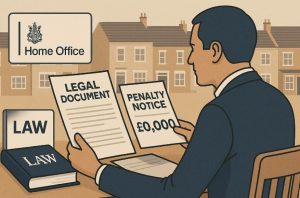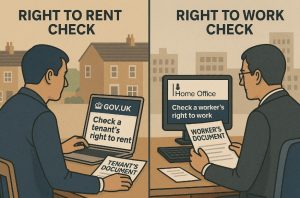The right to rent check is a mandatory step for landlords and letting agents in England when letting a residential property to a new tenant.
With the increasing digitisation of government services, checking a tenant’s right to rent using a share code is now a straightforward process that ensures legal compliance and safeguards against illegal renting practices.
This article will explain how to verify a tenant’s right to rent online, who needs a share code, and how landlords can efficiently use the government portal for this process.
What is the Right to Rent Share Code and Why is it Required?

A Right to Rent share code is a unique alphanumeric code issued by the UK Home Office that enables landlords or letting agents to confirm whether a prospective tenant is legally allowed to rent residential property in England.
This requirement is based on the Immigration Act 2014, which obligates landlords to ensure that anyone renting their property has the right to reside in the country.
The share code is part of a digital checking service and provides a temporary, secure way to verify a tenant’s immigration status without handling physical documents.
Only non-British and non-Irish citizens need to provide a share code. British and Irish nationals can have their right to rent confirmed through physical documents or a certified Identity Service Provider (IDSP).
The share code helps streamline the verification process while ensuring that sensitive personal and immigration data remains confidential and protected.
Who Can Check a Tenant’s Right to Rent Using a Share Code?
The responsibility for checking the right to rent rests with any individual or entity that is offering a tenancy agreement. The following groups are allowed and required to perform these checks:
- Landlords letting out a residential property in England
- Letting agents who are authorised by landlords
- Tenants subletting the property, where they assume responsibility for ensuring the subtenant’s eligibility
It is important to note that Right to Rent checks are only legally required in England. Landlords in Wales, Scotland and Northern Ireland are not subject to the same obligations.
Checks can be conducted either directly or through a representative. However, the responsibility for ensuring the accuracy and completeness of the check remains with the landlord unless otherwise agreed in writing.
What Information is Needed to Use the Right to Rent Share Code?
In order to carry out a Right to Rent check through the government’s online portal, landlords need two specific pieces of information from the tenant:
- The tenant’s date of birth
- The unique share code provided by the tenant
The share code is a nine-character combination of letters and numbers and is valid for 90 days from the date of issue. Tenants can generate the code through the GOV.UK ‘View and Prove your Immigration Status’ service.
Once generated, the code can be emailed to the landlord or handed over directly. Landlords should avoid storing the share code beyond the period required for legal compliance and should ensure secure handling of the data.
How Can Landlords Use the GOV?UK Right to Rent Online Portal?

To complete a Right to Rent check online, landlords should follow a specific sequence of actions through the GOV.UK portal:
- Visit the GOV.UK Right to Rent Check service.
- Select the option to check a tenant’s right to rent.
- Input the tenant’s share code.
- Enter the tenant’s date of birth as required.
- Review the results, which will indicate whether the tenant has the legal right to rent and any limitations tied to their status.
The results provided are legally binding and can be used as evidence of compliance if kept on file appropriately.
Process for Using the GOV.UK Portal
| Step | Action Required | Result Provided |
| Step 1 | Access GOV.UK website | Navigate to the ‘check a tenant’ page |
| Step 2 | Enter share code | Authenticates immigration status |
| Step 3 | Input date of birth | Confirms match with Home Office record |
| Step 4 | View right to rent outcome | Shows if the person has permission |
| Step 5 | Record and retain result | Used to show legal compliance |
Landlords should retain evidence of the completed check, including a dated copy of the right to rent result page, either digitally or in printed form.
What Types of Immigration Status Allow a Tenant to Use a Share Code?
A tenant is eligible to use a share code to prove their right to rent if they have one of the following immigration statuses or documents:
- A Biometric Residence Permit (BRP)
- A Biometric Residence Card (BRC)
- Settled or pre-settled status under the EU Settlement Scheme
- A visa granted through an application involving the UK Immigration: ID Check app
For tenants with a BRP, the share code can still be used for up to 18 months after the card’s printed expiry date, as long as their status remains valid.
This system ensures a consistent and reliable method for verifying eligibility, especially for individuals who no longer receive physical residence cards or who are transitioning to digital-only immigration proof.
Can a Tenant’s Documents Be Checked Without a Share Code?
Yes, landlords may also use physical documentation to perform a Right to Rent check, but only under specific conditions. This method is generally used when the tenant:
- Is a British or Irish citizen
- Cannot access the digital service due to lack of technology or circumstances
- Has physical documents such as a passport, certificate of naturalisation or travel document
In cases involving British and Irish citizens, landlords may also opt to use an IDSP that complies with government certification schemes.
The choice between using a share code and a physical document check depends on the tenant’s nationality and immigration status.
What Are the Legal Obligations and Penalties for Landlords?

The UK government has set clear guidelines for landlords to ensure compliance with Right to Rent laws. These include:
- Carrying out the check before the start date of the tenancy
- Recording the date of the check and keeping evidence
- Performing follow-up checks if the tenant’s right to rent is time-limited
- Reporting to the Home Office if a follow-up check shows that the tenant no longer has the right to rent
Failure to perform these checks correctly can result in fines of up to £3,000 per tenant and even criminal charges in some cases. Landlords who knowingly rent to individuals without lawful immigration status may face prosecution.
Legal Duties and Penalties for Right to Rent Non-Compliance
| Obligation | Description | Potential Penalty |
| Pre-tenancy verification | Conduct before tenancy starts | Civil penalty up to £3,000 |
| Documenting and recording | Save proof of check for at least 12 months post-tenancy | Mandatory |
| Follow-up checks | If time-limited status exists | Penalty if missed |
| Reporting expired status | Notify Home Office if status changes | Criminal charge in some cases |
Landlords should stay informed of updates from the Home Office regarding document types, share code usage, and regulatory changes affecting Right to Rent.
How to Deal With Issues in the Share Code Checking Process?
It’s not uncommon for landlords to encounter problems when attempting to check a tenant’s right to rent using a share code. Some of the most frequent issues include:
- Invalid or expired share codes that no longer work
- Typographical errors in the date of birth
- Tenants unaware of how to generate the code
- Technical problems on the GOV.UK portal
In such cases, the landlord should contact the tenant to reissue the code or verify the information. The GOV.UK portal includes help sections that guide users through resolving common technical issues.
For more complex problems, landlords can reach out to the Home Office Landlord Helpline or consult legal advice if there’s concern about legal implications or time-sensitive tenancy agreements.
What’s the Difference Between Right to Rent and Right to Work Checks?

Although the Right to Rent and Right to Work checks both involve verifying an individual’s immigration status, they serve entirely different legal purposes, are carried out by different types of organisations, and follow distinct procedures. Confusing these two checks can lead to non-compliance, legal issues, or missed responsibilities.
Purpose of Each Check
- Right to Rent Check: This check is designed to confirm whether an individual has the legal right to rent residential property in England. It is conducted by landlords, letting agents, or subletting tenants. The focus is on preventing individuals who do not have lawful immigration status from accessing private rented housing.
- Right to Work Check: This check is used by employers to determine whether a job applicant is legally allowed to work in the UK. It aims to stop illegal working and ensure that businesses do not unknowingly employ someone who lacks the appropriate immigration permission.
Who Performs the Checks?
- Right to Rent: Landlords, letting agents, and anyone offering a tenancy or licence to occupy property.
- Right to Work: Employers and HR professionals as part of the recruitment and onboarding process.
What is Being Verified?
- Right to Rent: Permission to rent a residential property in England based on immigration status.
- Right to Work: Permission to undertake employment or self-employment in the UK.
Methods of Verification
Both checks can be carried out through:
- Physical document checks (e.g. passport, residence permit)
- Digital share codes (for eligible non-UK nationals)
However, the systems used and the data viewed are different. While both use portals hosted on GOV.UK, the outcome of each check is tailored to its specific purpose.
Example:
- A share code generated for a Right to Rent check will not display employment eligibility.
- A share code for a Right to Work check will not confirm whether someone can legally rent property.
Legal Obligations
- Landlords must not let a property to someone who lacks the right to rent.
- Employers must not employ a person who is disqualified from working due to their immigration status.
Failure to comply with either check carries serious legal consequences:
- Landlords may face fines of up to £3,000 per tenant and possible criminal charges.
- Employers risk civil penalties of up to £20,000 per illegal worker, as well as potential disqualification from holding a sponsor licence or operating in regulated sectors.
Key Differences:
| Aspect | Right to Rent Check | Right to Work Check |
| Conducted by | Landlords or letting agents | Employers or hiring teams |
| Applies in | England only | Entire UK |
| Purpose | Verify eligibility to rent property | Verify eligibility to work legally |
| Share Code Validity | 90 days | 90 days |
| Penalties for Non-Compliance | Fines up to £3,000, possible criminal action | Fines up to £20,000 per worker |
| GOV.UK System Used | View a tenant’s Right to Rent | View a job applicant’s Right to Work |
Conclusion
Using a tenant’s right to rent share code is a crucial step in meeting legal responsibilities under UK immigration laws.
It offers a secure, fast, and government-backed method to verify a tenant’s right to reside in England.
Landlords should always obtain the share code and date of birth before agreeing to a tenancy, use the official GOV.UK portal, and maintain records for future reference.
Compliance not only protects landlords legally but also contributes to maintaining the integrity of the UK rental system.
FAQs About Right to Rent Checks and Share Codes?
What does the share code look like?
A share code is a 9-character alphanumeric code, typically in capital letters. It is case-sensitive and expires after 90 days.
Can landlords check right to rent without consent?
No. Landlords must have the tenant’s consent and share code to access their right to rent details through the GOV.UK portal.
How long should landlords keep a record of the check?
Records must be kept for at least one year after the tenancy ends, as evidence of compliance with immigration law.
Can a share code be reused?
A share code is unique and time-limited but can be reused for multiple checks within its 90-day validity.
What if the share code check shows ‘no right to rent’?
The landlord must not proceed with the tenancy. They should report the case to the Home Office to avoid liability.
Is the right to rent check required for lodgers?
Yes, if the lodger is paying rent or staying long term, landlords must conduct a right to rent check.
Are digital identity checks valid for all tenants?
Only British and Irish citizens can use IDSPs. All others must use a share code or show physical documents.






